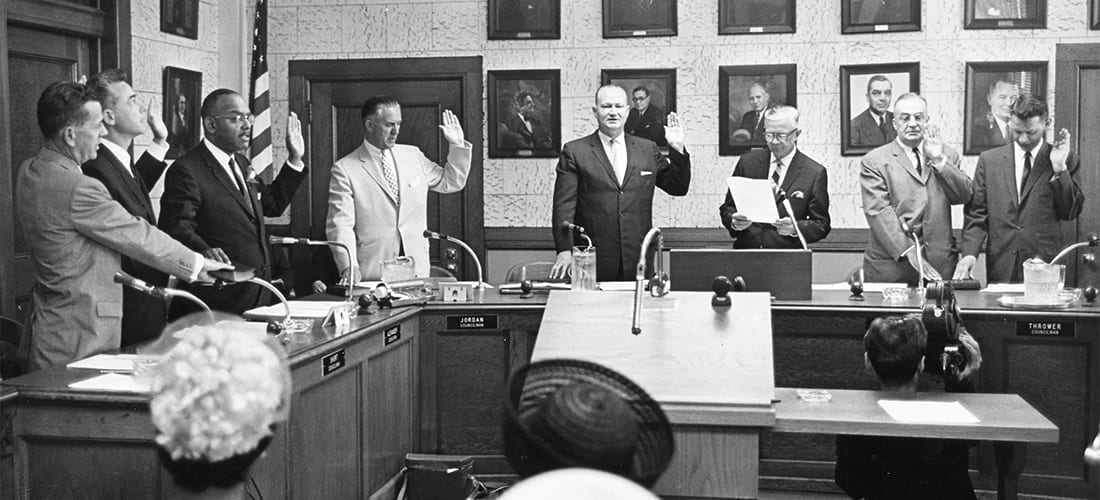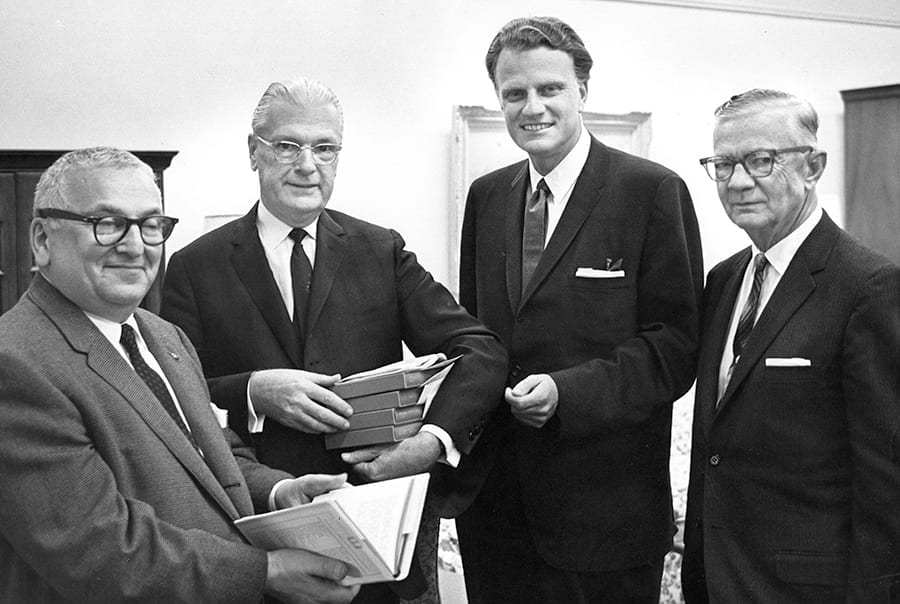Season of change
May 1, 2020

Charlotte City Council members take the oath at a 1965 meeting. From left, Jerry Tuttle, Milton Short, Fred Alexander, Sandy Jordan, Jim Whittington, Mayor Stan Brookshire, Claude Albea and John Thrower.
Before becoming a household name for uptown commuters, four-term Mayor Stan Brookshire helped propel race relations in the city.
by Virginia Brown
Emotions often run high as cars zip around Interstate 277-N in uptown Charlotte, merging, letting people in, cutting others off. Tangled and imperfect, the road gets us where we need to go. When Stan Brookshire, for whom the northeast loop of the freeway is named, was mayor in the 1960s, the city was much the same: complicated, and not without heightened emotions — but poised to move forward.
Stanford R. Brookshire was born on July 22, 1905 near Troutman, a small town just south of Statesville, about 35 miles north of Charlotte. He grew up with five brothers and two sisters and attended Duke University, where he studied history and was managing editor of the student newspaper. Following graduation, Brookshire moved to the Queen City with dreams of being a big-city newspaperman. The loud hum of The Charlotte Observer newsroom, though, coupled with a hearing defect, prevented his future in journalism.
The next chapter would have to be more peaceful.
A reluctant leader
When Brookshire got to Charlotte, ole Jim Crow had long dictated blacks’ access to restaurants, hotels and theaters throughout the South. In Brookshire’s new city, the atmosphere was no different. Blacks and whites were separated, even in death: Just north of uptown, a fence kept visitors to Pinewood Cemetery, where blacks were buried, away from Elmwood, which was reserved for whites.
“It was a time of social change. … We either had to accept change and make change work for the betterment of our city and community, or else we had to fight it,” Brookshire said in an interview with Edward Perzel for the WSOC-TV Oral History Project, years before he passed away in 1990.
Too young to serve in World War I, and too old for World War II, Brookshire had no intention of fighting.
Following a brief stint in construction with his father, who started out farming but later got into building, Brookshire went into business with his brother dealing industrial belts. He hadn’t planned to run for public office, but, after a year as president of the Charlotte Chamber of Commerce and at the urging of local business leaders, he ended up serving as mayor for four terms, from 1961-1969. None was particularly easy.
In May 1963, three months before Rev. Martin Luther King Jr. dreamt aloud on the national mall, he visited Charlotte to speak to students at the city’s black high schools. Around that time, local civil rights leader Reginald Hawkins had protested the city’s segregated establishments. Hawkins, a dentist who later ran for N.C. governor, believed the city’s progress toward desegregation wasn’t moving fast enough.
Brookshire, who had already established the biracial Charlotte-Mecklenburg Community Relations Committee, needed to act. Instead of going the way of Southern cities before him, he and several other white and black business owners started simply: They shared a meal.
The idea came from local cafeteria owner J. W. “Slug” Claiborne, a Charlotte restaurateur who operated several Slug’s restaurants and the Barclay Cafeterias. The idea was simple: Across town, every white member of the Charlotte Chamber of Commerce would go to lunch with a black member on the same day.
Brookshire walked into the Manger Motor Inn on 10th Street, a white establishment, with A.E. Spears, president of the black-owned Mechanics and Farmers Bank, and a professor from Johnson C. Smith University, and placed an order. Later that month, the chamber’s executive board unanimously voted to desegregate many of the city’s hotels, restaurants and movie theaters.
National model for desegregation
Though he was progressive for his time, Brookshire still clung to some old-fashioned values popular in his day concerning topics like interracial marriage, which he opposed. Still, his stances on broader civil-rights issues were more clear-cut.
“In my mind, there were no questions about which direction we should go,” Brookshire said in an interview in 1973. “After all, the blacks in this country are citizens. They were entitled to citizenship rights. To give them their requests for equal rights and opportunities was both legal and morally right.”
Just after becoming mayor, in 1961, Brookshire instituted an “urban-renewal” program in the uptown black community known as Brooklyn. It was Brookshire’s earnest way of showing the black community that the city was invested in improving their environment by furnishing better housing and providing opportunities in education and jobs.

“I’m convinced that if we hadn’t cleared Brooklyn … along with giving [blacks] equal citizenship rights … I think that we might have had such incidents here that they had in Watts,” Brookshire said, referring to the violent 1965 race riots in Los Angeles.
Whatever the intention, the repercussions of the program had a lasting, controversial effect. Many residents of Brooklyn — once a thriving African American community in what is now Second Ward — were displaced from the only home they knew. The urban-renewal program continues to be a hot-button topic today, with current Charlotte politicians pressing for minority involvement in the redevelopment of the former Brooklyn site.
Nevertheless, in July 1963, The Charlotte Observer reported that Attorney General Robert F. Kennedy said he was “particularly impressed” with Charlotte’s “striking progress” in desegregating area establishments.
Kennedy and other administration leaders called on Brookshire to provide more details about the local efforts to model for other communities beginning to take action toward desegregation.
“Our problems are not solely Negro or white, but interracial,” said John R. Cunningham, a former Davidson College president whom Brookshire had put in charge of his Mayor’s Committee of Community Relations. “I think the answers must come through interracial understanding, goodwill and cooperation,” he continued.
“Charlotte’s progressive action in May of 1963, at the same time that Birmingham was bringing out police dogs and firehoses, helped set the stage nationally for what became the hugely important 1964 Civil Rights Act,” says local historian Tom Hanchett.
A lasting legacy
Despite Charlotte’s early progress toward improved racial equality, there was more to be done during Brookshire’s tenure.
In 1969, Frederick D. Alexander, a funeral-home owner who had been the first black elected to Charlotte City Council, led the fight to remove the fence separating Elmwood and Pinewood cemeteries. City Council was deadlocked. With his deciding vote, Brookshire broke the tie, and the fence came down.
Today, the Charlotte-Mecklenburg Community Relations Committee is headed by Willie Ratchford, with the goal of improving communication among Charlotte’s diverse communities. With race-relation issues from the police shooting of Keith Lamont Scott to growing immigrant and refugee populations, the committee continues the work of Brookshire’s day.
In May 2013, 50 years after the famed “eat-in,” the committee urged residents to invite someone of a different race to lunch on the same day.
Brookshire passed away in October 1990. Shaded by the city’s signature crepe myrtles and oaks, the former mayor is laid to rest at Evergreen Cemetery, a pocket of east Charlotte where, fittingly, demographics are roughly one-third black, white and Hispanic. Inside the cemetery’s stone pillars, everyone is welcome. SP
Photographs courtesy of J. Murrey Atkins Library, UNC Charlotte